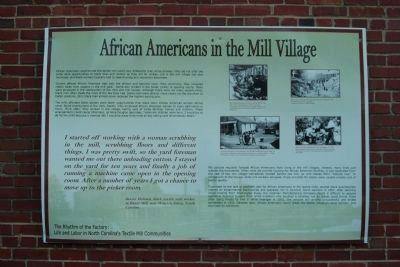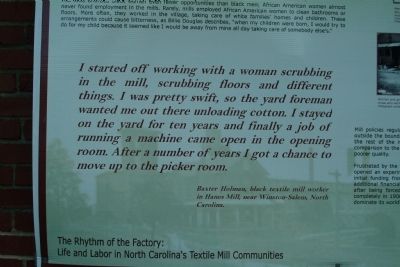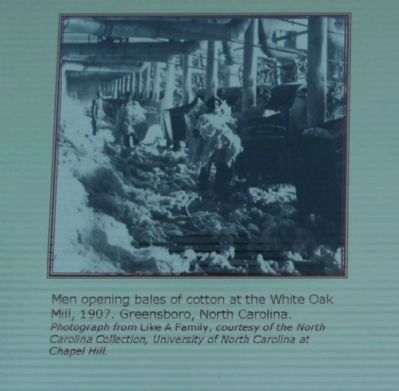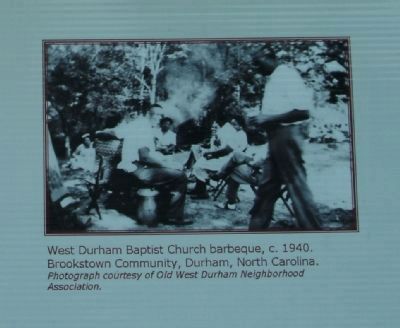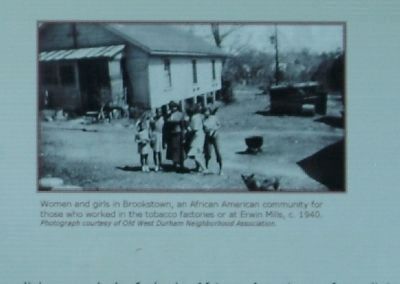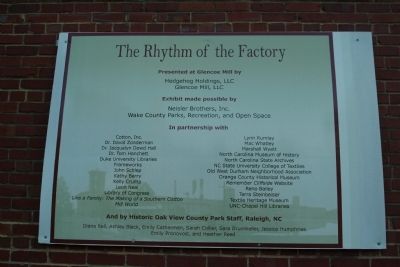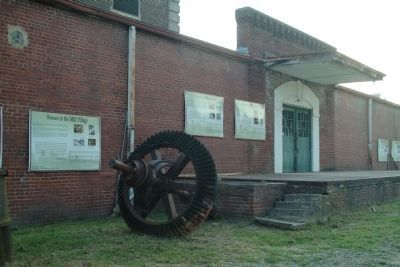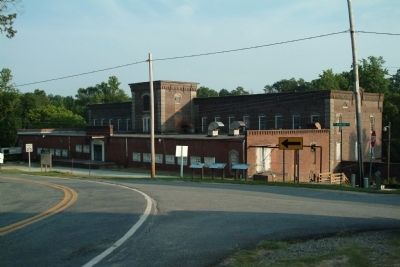Glencoe Village near Burlington in Alamance County, North Carolina — The American South (South Atlantic)
African Americans in the Mill Village
Owners offered African American men only the dirtiest and heaviest work. Most commonly, they unloaded cotton bales from wagons in the mill yard. Some also worked in the boiler, picker, or opening rooms. Many were employed in the construction of the mills and mill houses. Although there were not many opportunities, black men often made the most of the few they had. Some men were able to move slowly up the job chain to better positions. Still, black men almost never received the highest-paying jobs.
The mills afforded black women even fewer opportunities than black men; African American women almost never found employment in the mills. Rarely, mills employed African American women to clean bathrooms or floors. More often, they worked in the village, taking care of families’ homes and children. These arrangements could cause bitterness, as Billie Douglas describes, “when my children were born, I would try to do for my child because it seemed like I would be away from mine all day taking care of somebody else’s.”
I started off working with a woman scrubbing in the mill, scrubbing floors and different things. I was pretty swift, so the yard foreman wanted me out there unloading cotton. I stayed on the yard for ten years and finally a job of running a machine came open in the opening room. After a number of years I got a chance to move up to the picker room.
Baxter Holman, black textile mill worker in Hanes Mill, near Winston-Salem, North Carolina
Mill policies regularly forbade African Americans from living in the mill villages; instead, many lived just outside the boundaries. When mills did provide housing for African American families, it was separated from the rest of the mill village – sometimes located behind the mill, as with Hanes Mill’s “colored row.” In comparison to the houses white mill workers occupied, those provided for blacks were usually smaller and of poorer quality.
Frustrated by the lack of available jobs for African Americans in the textile mills, several black businessmen opened an experimental black-owned and operated mill in Concord, North Carolina in 1897. After securing initial funding from Washington Duke, the Coleman Manufacturing Company found it difficult to acquire additional financial support from white investors who doubted a business run by blacks could thrive. Even after being forced to hire a white manager in 1903, the venture still proved unsuccessful and ended completely in 1906. Decades later, African Americans would break the textile industry’s racial barriers, and dominate its workforce.
Topics. This historical marker is listed in these topic lists: African Americans • Industry & Commerce • Notable Places • Settlements & Settlers. A significant historical year for this entry is 1897.
Location. 36° 8.334′ N, 79° 25.677′ W. Marker is near Burlington, North Carolina, in Alamance County. It is in Glencoe Village. Marker is on Glencoe Street, on the left when traveling west. Glencoe Village is 3 miles north of Burlington, NC from NC Highway 62. Touch for map. Marker is at or near this postal address: 2406 Glencoe St, Burlington NC 27217, United States of America. Touch for directions.
Other nearby markers. At least 8 other markers are within walking distance of this marker. The Mill Buildings (here, next to this marker); A Legacy of Community (here, next to this marker); After the Whistle Blows (here, next to this marker); Men in the Mill Village (a few steps from this marker); Picker House and Dye House (a few steps from this marker); Women in the Mill Village (a few steps from this marker); Children in the Mill Village (a few steps from this marker); Living in a Mill-Centered World (a few steps from this marker). Touch for a list and map of all markers in Burlington.
Related markers. Click here for
a list of markers that are related to this marker. To better understand the relationship, study each marker in the order shown.
Additional keywords. Alamance Cotton Mill, Glencoe, Fabric, Textiles, Company Shops, Holt, Jim Crow era
Credits. This page was last revised on May 11, 2023. It was originally submitted on July 8, 2010, by Patrick G. Jordan of Graham, North Carolina. This page has been viewed 1,856 times since then and 63 times this year. Last updated on May 9, 2023, by Michael Buckner of Durham, North Carolina. Photos: 1, 2, 3, 4, 5, 6, 7, 8. submitted on July 8, 2010, by Patrick G. Jordan of Graham, North Carolina. • J. Makali Bruton was the editor who published this page.
